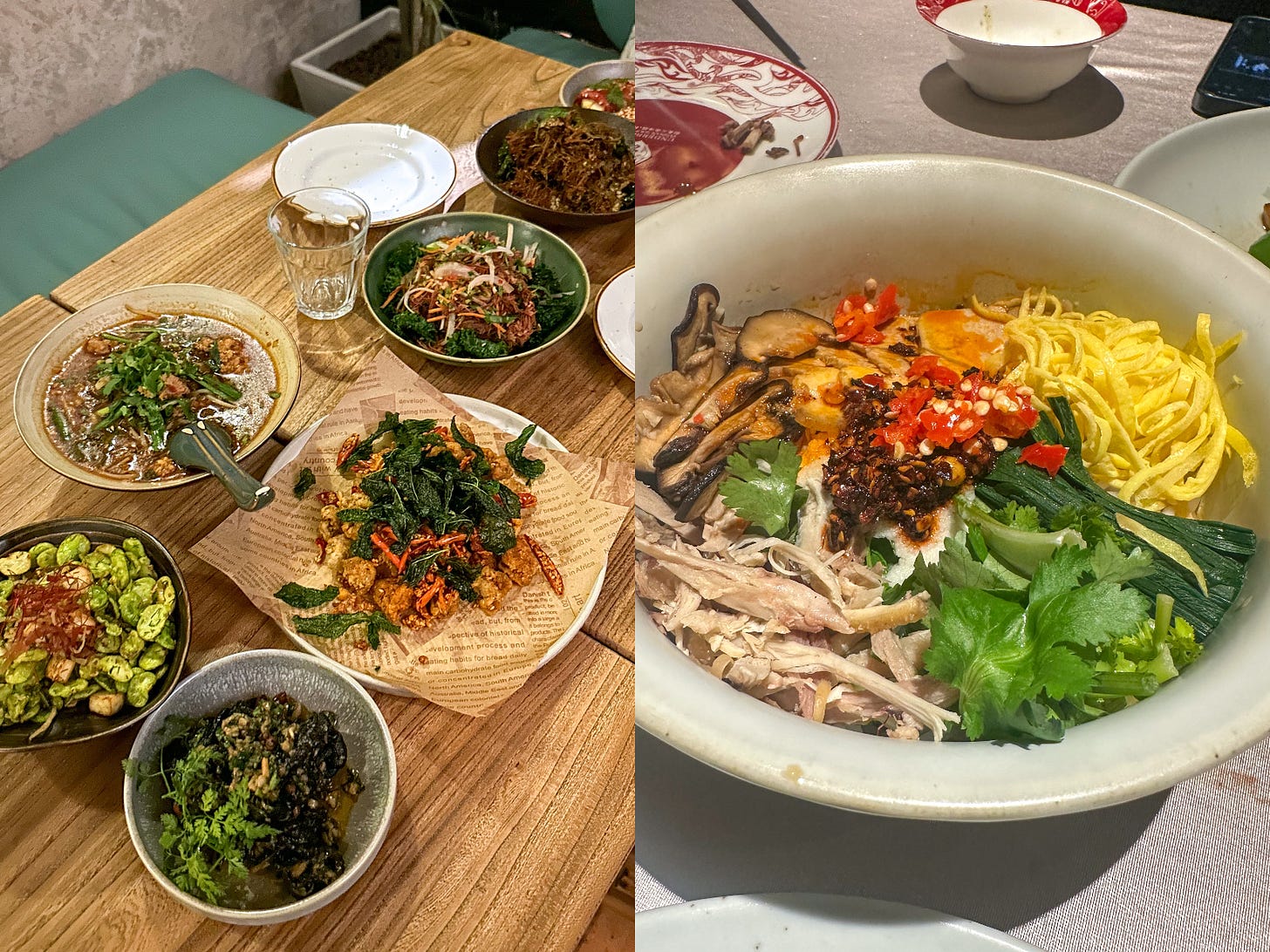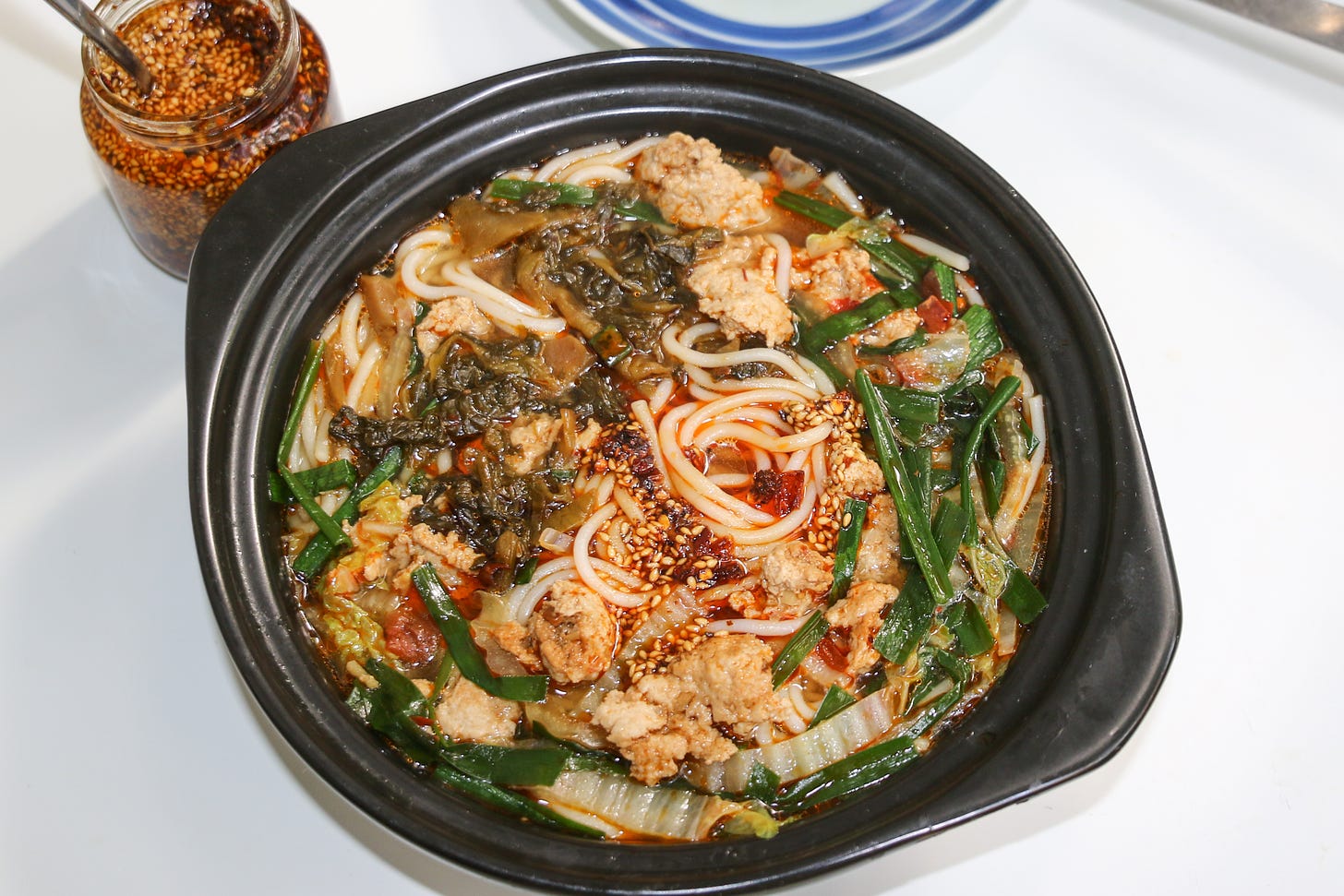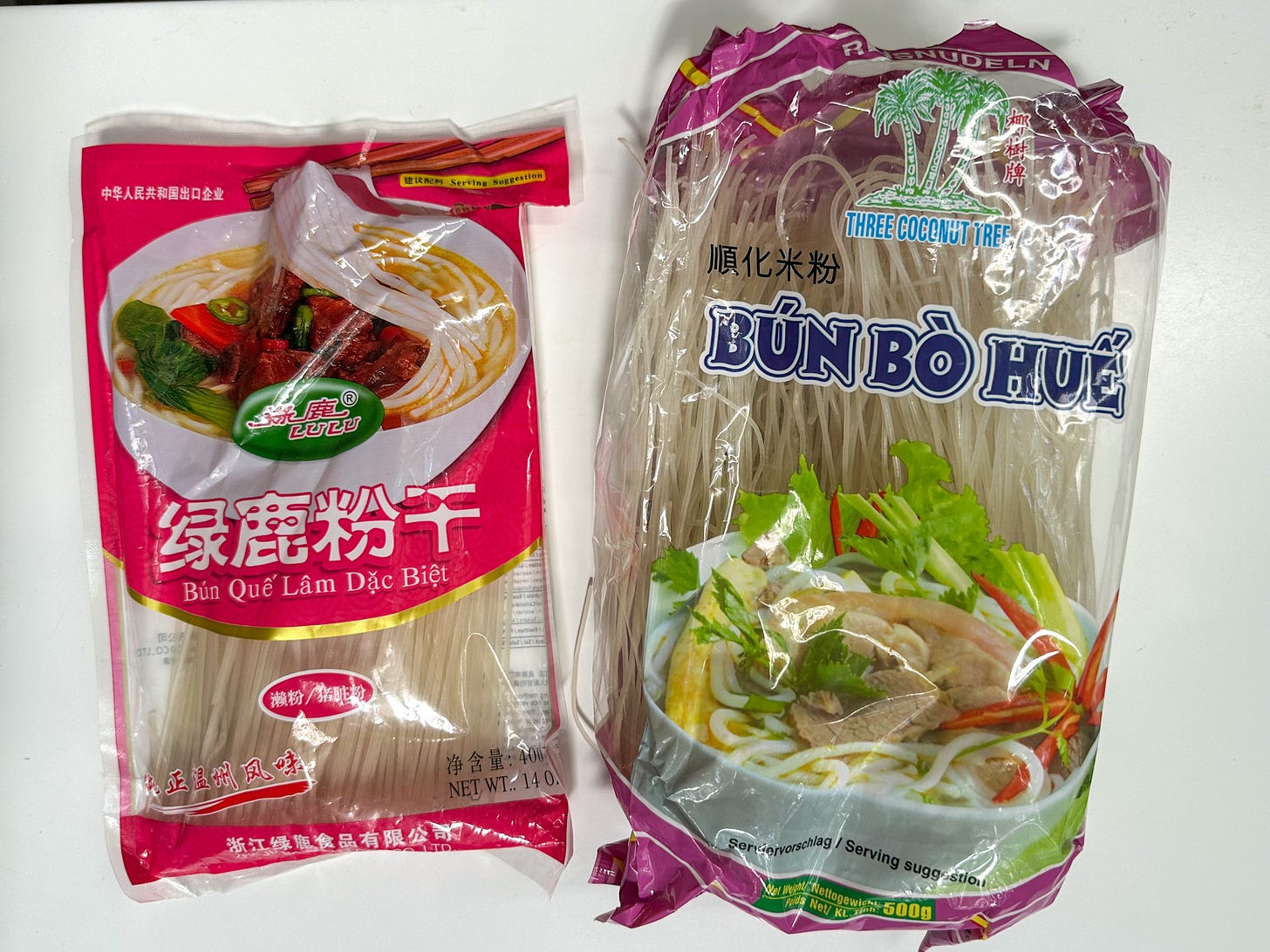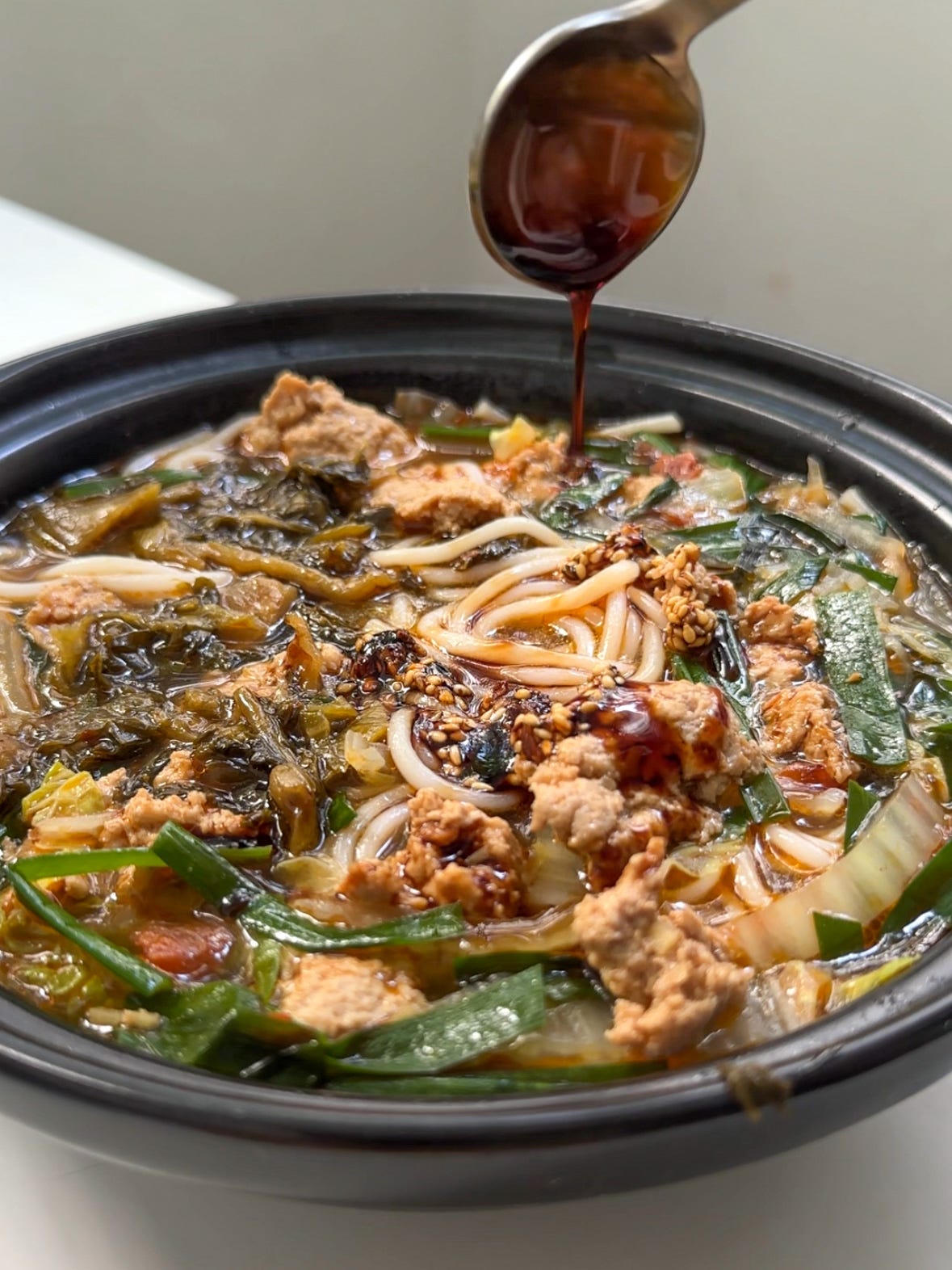Yunnan Small Pot Rice Noodle Soup (Xiaoguo Mixian)
A steamy, flavorful bowl of soup to cozy up with
Hi! We’re continuing our journey through regional Chinese noodles, and this time, we’ve traveled a little west from Sichuan’s Suan La Fen to Yunnan for a soothing, flavorful noodle soup perfect for colder days. I’ve also developed another variety of Yunnan rice noodle recipe for the Mala Market blog, stay tuned!
Yunnan cuisine is one of China’s regional food traditions that I believe deserves more attention. Bordering Vietnam, Laos, and Myanmar, the food of this southwestern region is rich with influences from Southeast Asian cooking traditions and abundant with local produce like herbs, edible flowers and wild mushrooms. While the most famous dish might be Cross Bridge Noodles (Guoqiao Mixian 过桥米线—a bowl of hot soup noodles served with small plates of toppings), Yunnan offers a myriad of rice noodle dishes, with nearly every city boasting its signature bowl.
In the capital city of Kunming, xiaoguo mixian (小锅米线), or small pot rice noodles, is especially popular. According to a book on Kunming’s city history, these noodles originated in Yuxi (玉溪), a city southwest of Kunming, and arrived in the capital with migrant workers in the early 20th century1 . The name hints at how the dish is prepared: a small copper pot with a long handle is used to cook fresh noodles in soup, usually in single-serving portions. Thanks to the pot’s quick heat conductivity, the dish is ready in just a few minutes (for homecooking I used sauce pan and clay pot instead).
The soup offers a balanced mix of savory, spicy, and umami flavors, and is typically served with a range of toppings (known as maozi or maoliao). Common choices include fermented greens, fresh vegetables, fried pork skin, braised meat, and even Asian swamp eel. My version uses a classic pork topping, adding the meat directly to the soup to create a “broken meatball” effect. In Wang Zengqi’s memoir, the beloved Chinese food writer who lived in Kunming during the Sino-Japanese War, this style is called cuan rou mixian (爨肉米线) 2. However, that name is rarely seen today, and this type of topping has become almost the default.
Simple as it might seem, one might claim you can’t replicate the flavors of Yunnan when you’re not there, it’s partly true as we don’t have access to the local ingredients such as the freshly made, slightly fermented rice noodles (known as sour batter rice noodles, suanjiang mixian 酸浆米线), or locally produced Zhaotong fermented chili soy bean sauce (昭通酱) and sweet soy sauce from Tuodong (拓东甜酱油). I’ve had the chance to have my parents bring the Zhaotong sauce, but never seen them in any Chinese supermarket here in Europe. Luckily, I discovered that mixing Sichuan doubanjiang with soybean paste creates a flavor profile that’s close enough. While this version may not be the only true Yunnan small pot rice noodles, even within Yunnan itself, there are likely a hundred ways to prepare this everyday dish, depending on where you go.

It’s been over 20 years since I last visited Yunnan, but I’ve tried to find Yunnanese flavors in other Chinese cities like Shanghai or Chengdu. This recipe is the result of watching countless YouTube food tours and documentaries (like this one, which follows a rice noodles shop owner’s day) and drawing inspiration from recipes by Michelle Zhao (I was lucky to try probably the best Yunnan food in Bergen, Norway from her) and Dianxi Xiaoge (she showed how to make the noodles from scratch). If you’re interested in learning more about Yunnan cuisine, I recommend checking out
’s book Cooking South of the Clouds, as well as the magnificent cooking videos from Dianxi Xiaoge and Dali-based Substack writer (this mushroom guide!!).Recipe for Small Pot Rice Noodles
Servings: 1
Ingredients:
100 g (3 oz.) dried rice noodles (round and thick)
For the pork patty:
90g (3 oz.) ground pork with fat
1/2 tbsp ginger, finely minced
1/4 tsp salt
1/4 tsp ground white pepper
2 tbsp water
For the soup:
1 tsp vegetable oil
2 tsp doubanjiang (Sichuan chili bean paste, read more here)
1 tsp huang dou jiang (soybean paste)
500ml (2 cups) chicken or pork bone broth
For the toppings and seasoning:
30g (1 oz.) garlic chives, cut into 5cm pieces
30g (1 oz.) vegetables (pea shoots, napa cabbage, or bean sprouts)
1 tbsp Chinese sweet soy sauce (store-bought or homemade)
1 tbsp light soy sauce
1-2 tbsp suan cai pickle (pickled mustard greens)
1 tbsp chili oil with sediments, more to taste
Instructions:
Cook the rice noodles: Soak your rice noodles in lukewarm water if time allows. In a pot of boiling water, cook the noodles over medium heat for 1-2 minutes less than the package instructions, until al dente. Drain and rinse under cold running water for 10 seconds. Transfer to a bowl of cold water to keep them bouncy.
Make the meat topping: In a bowl, combine the ground pork, ginger, white pepper and salt, then gradually add the water while mixing with chopsticks until absorbed and smooth, like a dumpling filling. Form into a thick, burger-shaped patty with hands.
Prepare the sauce for the soup: Mix the soybean paste and doubanjiang until smooth. In a small pot, heat the vegetable oil over low heat and fry the paste mixture until fragrant, then set aside.
Cook the soup: In a small saucepan or clay pot, bring the broth to a simmer. Add the pork patty and cook until it’s no longer pink, about 2 minutes. Use a spatula to break the patty into chunks, then add the paste mixture and stir to combine.
Assemble the dish: Add the chives, leafy vegetables, and rice noodles to the soup. Cook for about 2-3 minutes. Stir in the pickles, sweet soy sauce, light soy sauce and chili oil. Serve immediately.
To make this dish vegetarian, use tofu skin or dried tofu sheets instead of meat, and substitute with vegetable broth.
Notes on Making This Recipe:
Choosing Rice Noodles
The right type of rice noodles is key to this recipe. In Yunnan, fresh thick rice noodles are used, but here, I’m using dried round rice noodles that are at least 2mm thick. If you can source dried noodles from Yunnan, that’s ideal, but I’ve found that rice noodles from Jiangxi (labelled as Jiangxi Mifen 江西米粉) or Laifen 濑粉, or even Vietnamese Bun Bo Hue, work well.
Making Pork Bone Broth
Traditionally, eateries use a milky broth made from pig leg bones (筒骨汤) simmered for hours. I used chopped rib bones labelled just as Schweineknochen, and tested this recipe with both bone broth and chicken broth; both taste delicious. You can find an easy Chinese stock recipe here. Store-bought broth or bouillon powder/concentrate can also work in a pinch.
Finding Soybean Paste
Not to be confused with doubanjiang which is made mostly from fava beans, soybean paste, huangdoujiang (黄豆酱) is a fermented, non-spicy paste made from soybeans. Brands like Lee Kum Kee, Haitian and Liubiju (六必居) are good options. If you don’t have access to it, I think yellow miso and doenjang can also work.
Don’t Skip the Suan Cai Pickle
For small pot noodles, house-made suan cai (酸菜) or suan yancai (酸腌菜)—a pickled mustard green with salt and/or chili—is a must. It adds acidity and umami to the soup. I used a ready-made package from a brand called Yuquan 鱼泉, which is quite convenient. If you can’t find it, try other Chinese pickles like Xuecai, Yacai (used in Dandan Noodles) or even Zhacai (used in hot and sour noodles). They often are found at the pickle isle in Asian stores.
Old Kunming 《老昆明》, 2019
Wang Zengqi described this topping as adding fresh ground pork to the boiling soup: “爨肉即鲜肉末。米线煮开,拨入肉末,见两开,即得。”(汪曾祺《米线和饵块》)






love the photos on this one! have to make it soon.
Excellent post! I'm salivating already 😋. Thanks too for the wealth of intriguing links - we just watched the Dianxi Xiaoge vid. So beautifully produced - we plan to enjoy the rest in the series this weekend.